Did you know that there could be something hiding in your home or work environment causing all of your health issues?
Picture a family living in a seemingly normal house, but the mom gets chronic headaches and struggles with anxiety, the son has terrible allergies and is always congested, the daughter is overweight and seems to get sick too often, and the husband has GI issues. What they don’t know is that all of these health problems are being caused by one sneaky invader… mold.
What is mold and why should you care?
Mold is a fungus that can wreak havoc on your health and wellbeing without you even realizing it’s there. Mold can hide underneath carpeting, behind walls, inside of roofing, and within any crevice of your home, school, or workplace.
In the past few years I’ve have countless clients come into my online functional medicine practice suffering from a variety of health issues due to mold exposure. Most of them don’t even know it’s mold until we do proper testing to uncover this as a root cause of their health problems.
My personal experience with mold
I’ve even personally experienced many health challenges due to living in moldy environments, not realizing it until my health started to fall apart upon moving into a different space. Some of the tell tale signs that I’ve been exposed to mold are eczema, fatigue, sinus issues, and elevated thyroid antibodies. However, mold can produce a wide variety of symptoms such as headaches, memory issues, fibromyalgia, and digestive problems. Mold is often consider a “great mimicker” because the toxins produced from it, called “mycotoxins”, can trigger almost any kind of symptom or disease.
What are mycotoxins?
Mycotoxins are toxic compounds produced by certain types of fungi (molds) that can contaminate food crops, animal feed, and indoor environments. These toxins are byproducts of fungal metabolism and are known to be harmful to humans and animals when ingested, inhaled, or come into contact with the skin.
What is mold illness?
Mold illness is a subcategory of Chronic Inflammatory Response Syndrome (CIRS), also known as biotoxin illness. CIRS is an acute and chronic, systemic inflammatory response syndrome acquired following exposure to water-damaged buildings with resident toxigenic organisms and inflammagens including, but not limited to fungi, bacteria, endotoxins, and volatile organic compounds.
Mycotoxins accumulate in the body, triggering a systemic inflammatory response. Since this is not talked about in conventional medicine, it often gets completely missed as a possible root cause of symptoms or diseases. I’ve worked with clients who have seen dozens of doctors and searched for answers for many months, sometimes years, who didn’t find out the mold was the main culprit of their health issues until they found me. If you suspect you have mold illness due to having any of the following symptoms, I highly recommend booking a call with a functional medicine practitioner, such as myself or other, who is experienced in dealing with mold illness. This one discovery can change your entire life for the better.
Symptoms of mold exposure / mold illness:
Here’s a list of symptoms that can be from mold illness:
- Allergies
- Anxiety
- Anger
- Asthma developing or getting worse
- Autoimmune disease diagnosis (Hashimotos, Lupus, Scleroderma, Psoriasis, etc.)
- Bronchitis
- Brain fog
- Chronic cough
- Digestive issues like constipation, diarrhea, stomach pains, etc.
- Depression
- Difficulty concentrating
- Eczema
- Exercise fatigue
- Fatigue
- Fibromyalgia
- Hallucinations
- Headaches and migraines
- Issues recollecting words
- Irritability
- Inability to cope with stress
- Joint pain
- Mast Cell Activation Syndrome (MCAS)
- Metallic taste in the mouth
- Muscle pain
- Muscle aches
- Muscle cramps
- Multiple chemical sensitivity
- Nasal drip
- Nausea
- Nightmares
- Numbness
- OCD
- Poor memory
- Respiratory infections
- Red, itchy eyes
- Runny nose
- Shortness of breath
- Sensitivity to light
- Sense of internal vibration
- Skin rashes
- Sinus congestion
- Tingling
- Tremors
- Temperature regulation problems
- Vertigo
How these mycotoxins damage your health
Mycotoxins can be very damaging to your health, and just to hit this point home further for you, here’s some other examples on what these toxins can do.
Ochratoxin (OTA) mycotoxin effects
Ochratoxin (OTA), a type of mycotoxin that is produced by molds of the Aspergillus and Penicillium families, is toxic to the immune system and kidneys, plus it a cancer causing agent. Not only has OTA been shown to lead to oxidative damage to the brain, but dopamine levels in the brains of mice have been shown to decrease after OTA exposure. I often see low levels of dopamine on my clients lab results who are dealing with mold illness, and their symptoms of depression, lack of motivation, and sleep issues match up with these findings.
Gliotoxin (GTX) mold toxin effects
Gliotoxin (GTX) is another mold toxin produced by Aspergillus mold. It inhibits impairs the activation of T-cells (white blood cells that help your immune system protect you) and induces apoptosis (cell death) in monocyte-derived dendritic cells which are involved in inflammation and infection. Not only does this lead to immune system suppression, but this can lead to neurological symptoms.
Citrinin (CTN) mycotoxin effects
Another mycotoxin called Citrinin (CTN) is produced by the molds Aspergillus, Penicillium, and Monascus. CTN exposure can increase permeability of mitochondrial membranes in the kidneys, and has been shown to be carcinogenic in rat studies.
My clients’ experiences with mycotoxins
I have seen mycotoxins do mischievous work on organs in the body. I have worked with multiple clients who have had pancreatitis and kidney damage after exposure. Also in my practice, I have been able to correlate a wide variety of autoimmune diseases with mold exposure, such as Hashimotos, Lupus, and Scleroderma.
Why doesn’t everyone get extremely sick in a damp or moldy building?
Sometimes not everyone living or working in a damp, moldy environment gets extremely sick from the exposure. Certain people have a genetic susceptibility to develop mold illness based on their genes. Certain HLA genes are said to make someone more susceptible to mold illness. Approximately 25 % of the population has these HLA gene types that make them unable to combat the mycotoxins, creating a chronic inflammatory immune response. However, if you do not have this gene, you can be have adverse effects and should not rule out mold illness right away.
The extent of adverse health effects from mycotoxins depends on the extent of exposure (dosage and period of time), the type of mycotoxin, genetic predisposition, and current health status.
How do buildings obtain mold and how common is this?
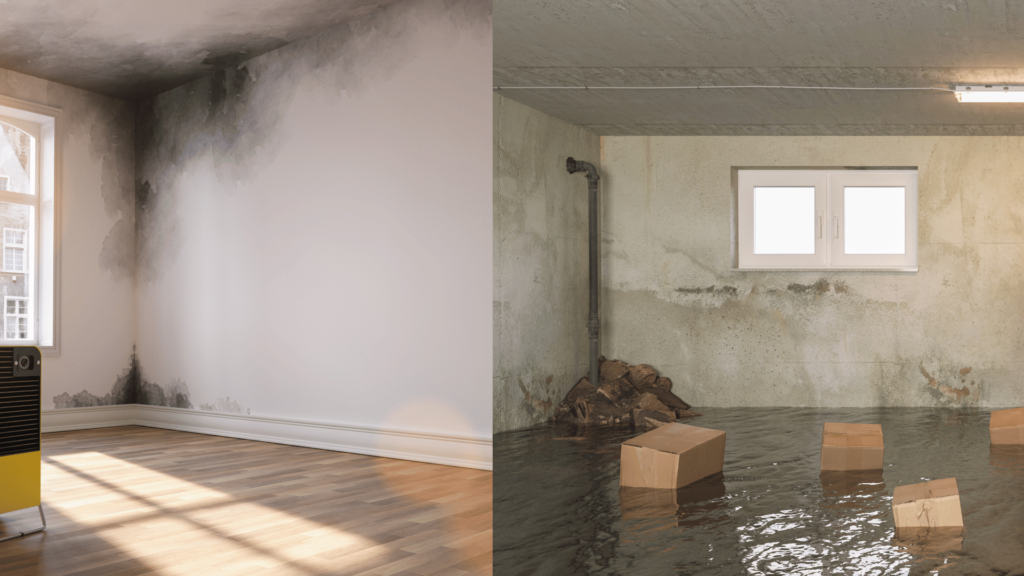
Fungi, bacteria and other microbes start populating in buildings with water leaks, indoor condensation, flooding from extreme weather events, poor ventilation, inadequate caulking, faulty construction of crawl spaces, improper roofing, and other construction defects.
Buildings with dampness and mold vary depending on the country and region. A study of 831 residential homes from 75 different locations in the U.S. reported that 24% of the surveyed homes had moisture or mold problems. [1] The population-weighted average prevalence of dampness/mold estimated from several published studies was 47%. [2] The U.S. EPA (Environmental Protection Agency) BASE (Building Assessment Survey and Evaluation) study of 100 randomly selected public and commercial office buildings across the U.S. conducted during 1994 through 1998 showed that 85% of the buildings experienced past water damage and 45% had current leakage problems. [3]
Chances are likely that you’ll be exposed at some point in your life, whether that’s an apartment or house that you live in, a building you work in, school you attend, or various places you visit.
Do you have mold in your home or workspace?
Signs there may be mold in your home or workspace:
- Indoor humidity over 50% (or you live in a humid area)
- Water damage that was not addressed within 48 hours
- Recurring leaks through your roof, windows, sinks, etc.
- Musty smell
- Know drainage issues in your home
- Visible mold on surfaces
- You have health issues that started after moving into a new home or workspace
Is dead mold in your home safe?
If mold looks like it is no longer growing and becomes inactive, it is considered “dead”. However, dead mold still produces allergens, irritants, and toxigenic substances. It’s important to let a professional handle the mold removal, since handling it yourself can impact your health when inhaled or touched. Additionally, the presence of dead mold indicates that there was an underlying moisture problem that supported mold growth, which needs to be addressed to prevent future mold issues.
Should I be worried about mold in food?
If you see visible mold on food… obviously do NOT eat it. However, mycotoxins are invisible to the naked eye and can contaminate various foods. Currently, scientists have identified and reported over 300 mycotoxins. However, only a few of these mycotoxins regularly contaminate food and animal feed. These contaminants are aflatoxins (AF), ochratoxins (OT), fumonisins, patulin, zearalenone (ZEA), and trichothecenes including deoxynivalenol (DON) and T-2 toxin. [4]
What about low levels of mycotoxin exposure?
Low levels of these mycotoxins are unavoidable in animal feed and food. Since toxic mold grows in warm, moist climates, crops with highest levels of mold tend to be in rural regions of sub-Saharan Africa, Southeast Asia and China, where governments do not closely regulate food storage and processing. [6] [7] [8] [9]
A 2010 study looking at the global burden of Aflatoxin-induced Hepatocellular Carinoma (liver cancer) showed that of the 550,000–600,000 new Hepatocellular carcinoma (HCC) cases worldwide each year, about 25,200–155,000 may be attributable to aflatoxin exposure. Most cases occur in sub-Saharan Africa, Southeast Asia, and China where populations suffer from both high HBV prevalence and largely uncontrolled aflatoxin exposure in food. Aflatoxin may play a causative role in 4.6–28.2% of all global HCC cases. [5]
List of foods that contain mycotoxins
Despite the health destruction these toxins can do, countries including the United States allow for low amounts of mycotoxins in food products. Foods that contain mycotoxins include the following:
- nuts (walnuts, cashews, almonds, pistachios, Brazil nuts)
- peanuts
- corn (one of the most susceptible crops to mold)
- grains such as wheat
- dairy (milk, cheese)
- dried fruits
- coffee
- wine
- apple juice
You can find the US and EU limits on food and animal feed levels in the chart below gathered from a 2017 articles titled Occurrence, Toxicity, and Analysis of Major Mycotoxins in Food published in the International Journal of Environmental Research and Public Health.
US and EU mycotoxin limits on food and animal feed levels
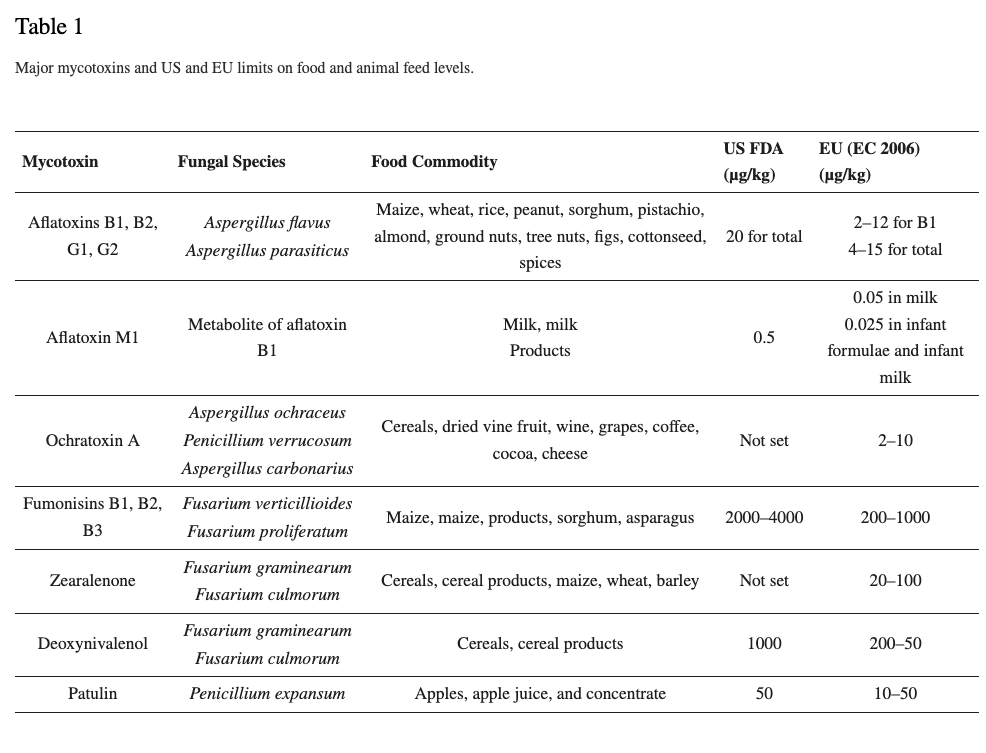
US FDA fumonisin levels for animal feed and human foods
The US FDA Fumonisin levels for animal feed are much higher than that of human foods. For example, corn products can have 2-4 ppm (parts per million) or 2000-4000 ug/kg (micrograms / kilogram), while the corn farmers use to feed poultry that they raise for slaughter is as high as 100 ppm or 100,000 ug/kg.
However, if the US if allowing poultry and other animals to eat these corn and grain-based feeds with higher amount of mycotoxins, this may affect the health of the animals, causing more inflammation. Eventually you are consuming those animals if you choose conventional animal products. This is one of many reasons why I recommend 100% grass-fed, organic, pasture raised animal meats. I trust US Wellness Meats for my 100% grass-fed products and you can shop with them online here.
The chart below is directly from the FDA website and you can see the entire webpage here.
You can find the rest of the FDA limits for mycotoxins on this webpage.
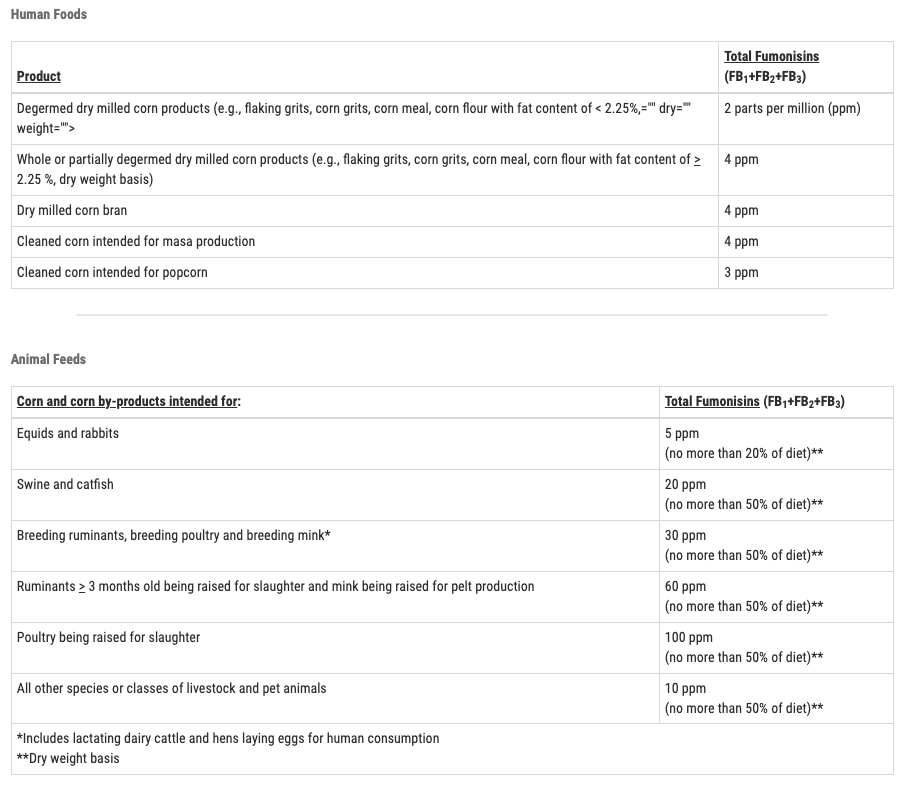
Since the U.S. Food and Drug Administration and the USDA has set limits for foods like corn and peanuts in order to limit how much aflatoxin reaches the human food chain and livestock feed, consuming certain foods in the US and EU are safer than other countries such as China. However, it’s still important to understand that the foods I’ve mentioned so far are likely to have some mycotoxins on them. If you are living in the US or EU, your biggest concerns regarding mycotoxins will come from water damaged buildings.
What do you do about mold in your environment?
If you have mold in your environment, you need to get rid of the mold because you cannot fully heal in a moldy environment.
Step 1 – Testing:
The first step is finding an indoor environmental professional to come test and inspect the environment you suspect may have mold.
Here are some examples of companies you may consider using:
If you do get a test on your own, I highly recommend an ERMI test that you can find here.
- ERMI testing (We prefer the Swiffer method)
- Although professionals like myself prefer ERMI, Immunolytics is another option that is more affordable. Immunolyctics can also be great for testing your car… yes, mold can be in your car too!
Step 2 – Remediation or moving:
Once you’ve tested and confirmed, remediation takes place. The mold inspection company determines this and he next best steps for your situation. An alternative option would be moving to a new home or office space.
Step 3 – Cleaning or ridding of your belongings:
If your space has mold, your belongings have mycotoxins on them. In cases of terrible mold exposure or if you want to be certain you get rid of it all for good, you may consider getting all new belongings or at least the belongings made of soft, porous materials. For example, you can get away with keeping your kitchen table and TV because you can easily clean these, but you may want to consider a new sofa or mattress.
I know that starting from scratch with new belonging is not possible for everyone because of the cost involved. An alternative option is to clean your belongings as best as possible. I like to use Microbalance mold killing products.
You can clean your clothing with the laundry cleaner, spray and wipe items down with their sprays, and even fog your entire home with their products. Mold remediation companies usually fog your home after they finish with remediating as well.
Step 4 – Clean up your air:
Once you’ve remediated and cleaned up your belongings, it’s time to get high quality air filters and purifications systems.
I like Hypoair because their technologies get rid of up to 99.9% of viruses, mold, bacteria, chemicals, odors, and dust. You’ll save money when you use my code NaturalHealthRising, so head to hypoair.com and start making your home cleaner and safer for you and your whole family. If you own your home, I recommend getting the HVAC system purifier so that you can cover your entire home. If you do not own your home or you tend to move a lot, I recommend getting some of their smaller devices. Another air purifier that I like is Air Doctor.
If you are shaking your head thinking, “there’s no way I can pay for a remediation”… at least get yourself these high quality air purifiers for your home and make sure you use a MERV10 or higher rated filter for your HVAC system in your home that you change regularly. Try to spend as little time as possible in the moldy environment, and save up money until you are able to get a remediation or move.
What about testing your body?
There are two different tests I utilize that show my clients have mold.
GPL MycoTOX by Mosaic Diagnostic
Once of the tests I use is the GPL MycoTOX by Mosaic Diagnostic, which is Mosaic Diagnostics’ most comprehensive assessment of mycotoxins. This test is a state-of-the art urine-based assay that accurately assesses levels of 11 different mycotoxins, including Aflatoxin M1, Ochratoxin A, Zearalenone, and Trichothecenes. This is the main test I would recommend running to identify which mycotoxins are present systemically in your body.
Why is it important to identify the mycotoxins in your body?
First off, it’s good to have a “before” level before we get started with detoxing from the mold in a protocol. That way, 6 months through working with my clients on a mold detox protocol, we can retest levels and make sure we have gotten rid of the mycotoxins, and if not we will proceed with a longer protocol. Mold toxins can take 6 months or longer to get out of your system with proper nutrition, lifestyle, and supplement support. There are also different binders that are better at tackling different mycotoxins, so understanding which ones are in your body are important for the best approach.
Organic Acids Test (OAT) by Mosaic Diagnostics
The second test is the Organic Acids Test (OAT) by Mosaic Diagnostics. Organic acids are products of the body’s metabolic pathways, and looking at these provides insight into important areas related to gut health, mitochondrial dysfunction, neurotransmitter status, indicators of detoxification and macronutrient breakdown and nutritional status. This test does show some levels of fungal overgrowth including candida and a few of the mycotoxins localized in the gut. However, this test does not replace a comprehensive mycotoxin test.
Typically if mold is present, that’s not the only thing out of balance in the body. There’s usually multiple stressors triggering symptoms, such as other unfriendly microbes in the gut, heavy metals, and nutrient deficiencies. This is where I would look at more tests, depending on the person’s symptoms, to put all of the puzzle pieces together for optimal healing.
Here are some other labs I may consider:
- GIMAP by Diagnostic Solutions to look at gut pathogens and digestive health.
- DUTCH Plus to look at adrenal gland health and overall sex hormone health.
- Hair Tissue Mineral Analysis Test (HTMA) to look at mineral imbalances and heavy metals.
- I may run a NutrEval, comprehensive blood panel, or food sensitivities as well.
Everyone is unique, so I determine which tests are best fit for you to use when we work together during a free health consultation call on Zoom. You can book that free call here.
Remember, always test – don’t guess!
How do you ultimately detox from mold?
Clearing your system from mold is a complex process and I highly recommend you to work with a functional medicine practitioner like myself to help you through the process. It takes 6 months or more to get your body back to mold-free.
Click here to book a FREE health call with me to discuss next steps for you:
What does the detox process look like?
Supplements
The process involves taking a wide variety of supportive supplements like glutathione, NAC, and binders. I only use high quality, professional-grade supplements so that the protocols are effective. When you work with me, you get access to these supplements at a 15% discount.
Nasal sprays
I use nasal sprays for mold spores in the sinuses. You will incorporate additional lifestyle practices such as sweating to assist in moving the mold toxins out of the body. In order to reduce inflammation and fungus, you will eat a specific, clean diet during the process.
Addressing underlying causes
I will also help you address other underlying causes such as gut issues, nutrient deficiencies, and hormone imbalances that often come alongside mold. I even go to the extent of helping my clients rebalance their nervous system and reduce stress, since mold illness can be a very taxing and overwhelming experience.
Mold detox is bio-individual
Every single person is unique. There is no one-size-fits-all approach when it comes to healing from mold. We always start with testing and not guessing, so that I can figure out the best plan of action for you.
I’ve seen people go from having brain fog, fatigue, chronic headaches, and autoimmune diseases, to feeling energized, mentally clear, and in remission with their symptoms after going through a full remediation and detoxification process. I’ve had countless clients do this, and you can too.
Book a free health consultation zoom call with me so that we can see if I am the right person to help you get rid of mold for good and get you feeling healthy once again.
A reminder when you are suspecting mold exposure
Remember, it’s essential to prioritize your health and wellness, and if you suspect mold exposure, do not hesitate to take action.
Addressing mold exposure and CIRS is no easy feat, but you’ve made it this far, and that’s something to be proud of. With the right help, you’ll be on your way to the healthiest, happiest version of yourself.
By working with a functional medicine practitioner, you can customize your detox and healing process to fit your unique needs, and that’s the secret sauce to success.
So, what are you waiting for?
Click here to book a FREE health call with me to discuss next steps for you.
Disclosure: Some of the links above are affiliate links, meaning that at no additional cost to you, I will receive a commission if you click through and make a purchase
Sources
[1] Salo, P. M., Arbes, S. J., Crockett, P. W., Thorne, P. S., Cohn, R. D., & Zeldin, D. C. (2008). Exposure to multiple indoor allergens in US homes and its relationship to asthma. The Journal of Allergy and Clinical Immunology, 121(3), 678-684.e2. https://doi.org/10.1016/j.jaci.2007.12.1164
[2] Prevalence of Building Dampness | Indoor Air. (n.d.). https://iaqscience.lbl.gov/prevalence-building-dampness
[3] Prevalence of Potential Sources of Indoor Air Pollution in U.S. Office Buildings | Indoor Air Quality (IAQ) | US EPA. (n.d.). https://19january2017snapshot.epa.gov/indoor-air-quality-iaq/prevalence-potential-sources-indoor-air-pollution-us-office-buildings_.html
[4] Alshannaq, A., & Yu, J. H. (2017). Occurrence, Toxicity, and Analysis of Major Mycotoxins in Food. International Journal of Environmental Research and Public Health, 14(6), 632. https://doi.org/10.3390/ijerph14060632
[5] Adetunji, M. C., Aroyeun, S. O., Osho, M. B., Sulyok, M., Krska, R., & Mwanza, M. (2019). Fungal metabolite and mycotoxins profile of cashew nut from selected locations in two African countries. Food Additives & Contaminants: Part A, 36(12), 1847–1859. https://doi.org/10.1080/19440049.2019.1662951
[6] Adetunji, M. C., Alika, O. P., Awa, N. P., Atanda, O. O., & Mwanza, M. (2018). Microbiological Quality and Risk Assessment for Aflatoxins in Groundnuts and Roasted Cashew Nuts Meant for Human Consumption. Journal of Toxicology, 2018, 1–11. https://doi.org/10.1155/2018/1308748
[7] Adetunji, M. C., Alika, O. P., Awa, N. P., Atanda, O. O., & Mwanza, M. (2018). Microbiological Quality and Risk Assessment for Aflatoxins in Groundnuts and Roasted Cashew Nuts Meant for Human Consumption. Journal of Toxicology, 2018, 1–11. https://doi.org/10.1155/2018/1308748
[8] Le, L. H. T., Tran-Lam, T., Nguyen, H. Q., Quan, T. C., Nguyen, T. Q., Nguyen, D. T., & Dao, Y. H. (2021). A study on multi-mycotoxin contamination of commercial cashew nuts in Vietnam. Journal of Food Composition and Analysis, 102, 104066. https://doi.org/10.1016/j.jfca.2021.104066
[9] Fang, L., Bi, Z., Zhang, R., Wu, P., Zhao, D., Chen, J., Pan, X., Wang, J., Wu, X., Zhang, H., Qi, X., Zhou, J., & Zhou, B. (2022). Occurrence and exposure assessment of aflatoxins in Zhejiang province, China. Environmental Toxicology and Pharmacology, 92, 103847. https://doi.org/10.1016/j.etap.2022.103847
ADDITIONAL RESOURCES:
Surviving Mold https://www.survivingmold.com/resources-for-patients/diagnosis
FDA Mycotoxoins https://www.fda.gov/food/natural-toxins-food/mycotoxins
Mosaic Diagnostics – https://mosaicdx.com/resource/great-plains-lab-is-now-mosaic-diagnostics/
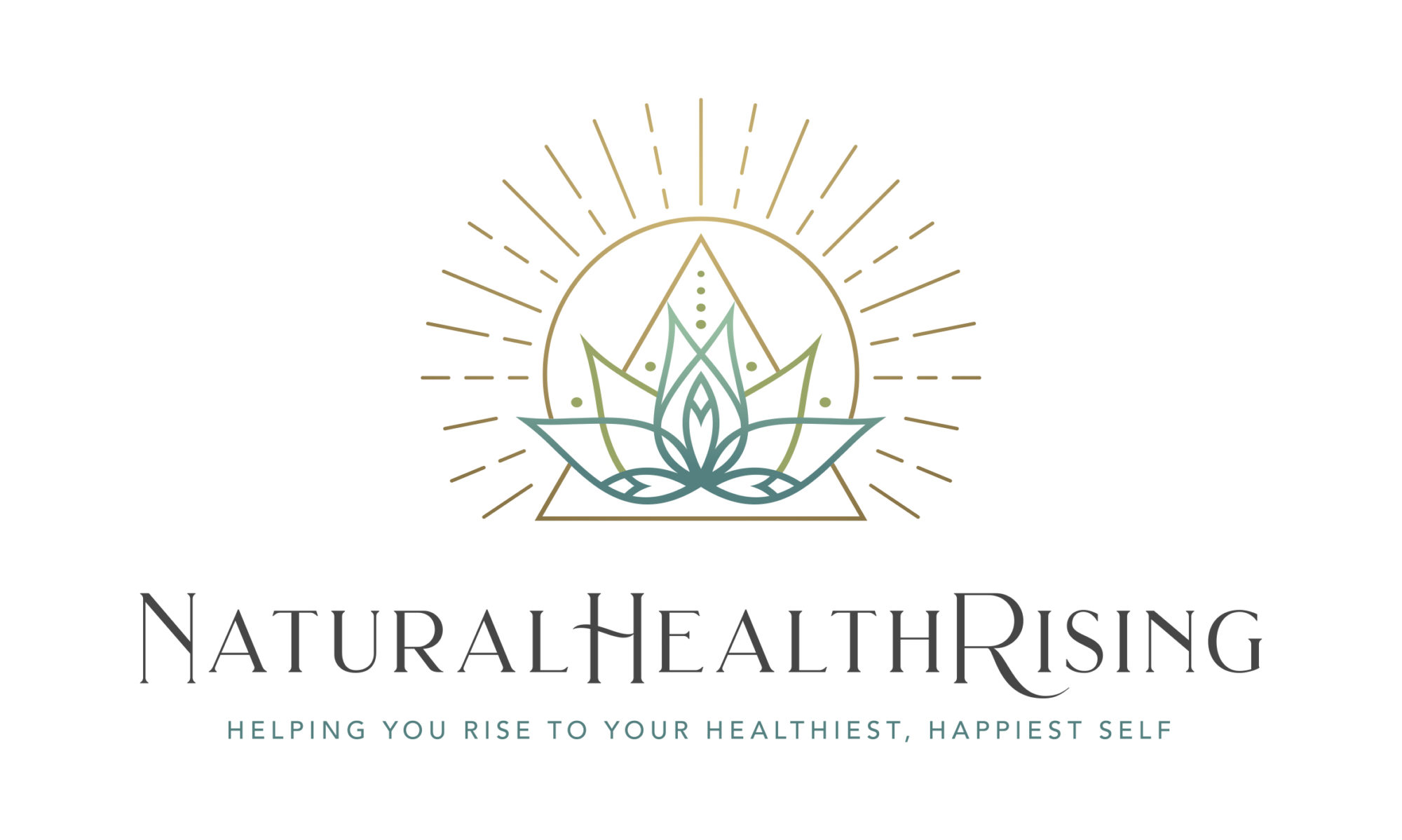
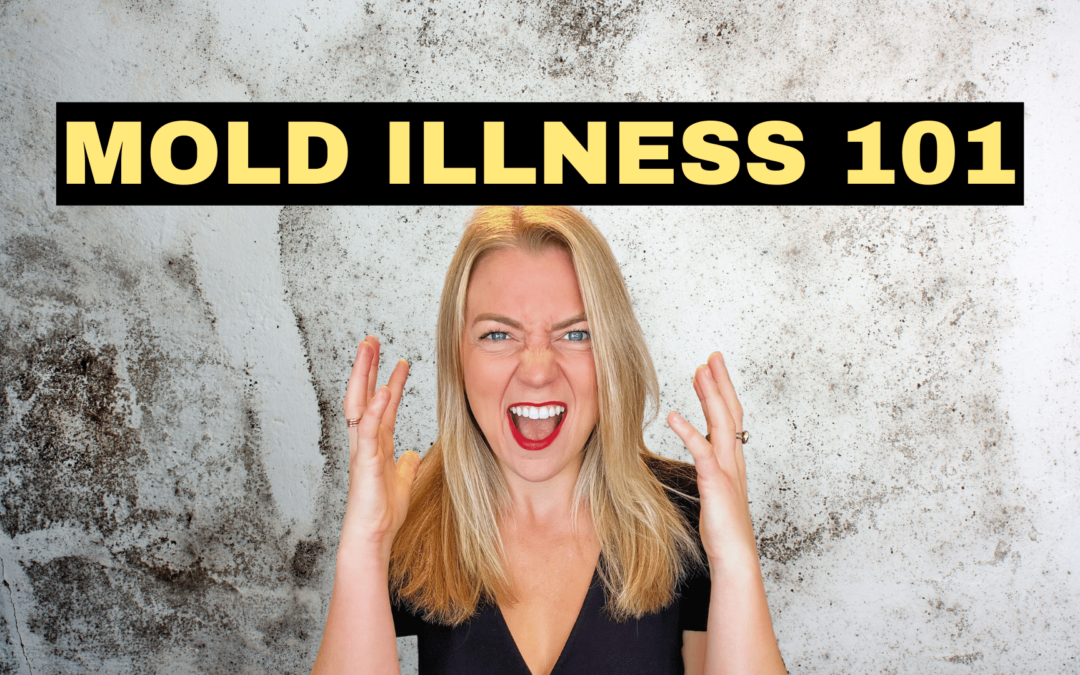
Recent Comments